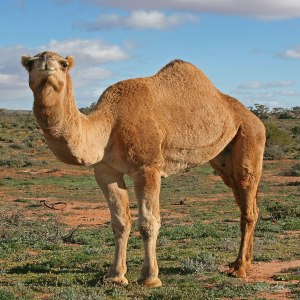 The dromedary , also called the Arabian camel , is a large, even-toed ungulate with one hump on its back. The dromedary is the smallest of the three species of camel. Adult males stand 5.9-6.6 ft. at the shoulder, while females are 5.6-6.2 ft. tall. Males typically weigh between 880 and 1320 pounds and females weigh between 660 and 1,190 pounds. The species’ distinctive features include its long, curved neck, and narrow chest, a single hump (compared with two on the Bactrian camel and wild Bactrian camel), and long hairs on the throat, shoulders and hump. The coat is generally a shade of brown. The hump 7.9 inches tall or more, is made of fat bound together by fibrous tissue. They have several adaptations, such as the ability to tolerate losing more than 30% of its total water content, which allows it to thrive in its desert Habitat. They have thick, double layered eyelashes and bushy eyebrows. Their vision is sharp and their sense of smell is good. The male has a soft palate nearly 7.1 inches long which it inflates to produce a deep-pink sac, which dangles from one side of the mouth and is used to attract females during the mating season.
The dromedary , also called the Arabian camel , is a large, even-toed ungulate with one hump on its back. The dromedary is the smallest of the three species of camel. Adult males stand 5.9-6.6 ft. at the shoulder, while females are 5.6-6.2 ft. tall. Males typically weigh between 880 and 1320 pounds and females weigh between 660 and 1,190 pounds. The species’ distinctive features include its long, curved neck, and narrow chest, a single hump (compared with two on the Bactrian camel and wild Bactrian camel), and long hairs on the throat, shoulders and hump. The coat is generally a shade of brown. The hump 7.9 inches tall or more, is made of fat bound together by fibrous tissue. They have several adaptations, such as the ability to tolerate losing more than 30% of its total water content, which allows it to thrive in its desert Habitat. They have thick, double layered eyelashes and bushy eyebrows. Their vision is sharp and their sense of smell is good. The male has a soft palate nearly 7.1 inches long which it inflates to produce a deep-pink sac, which dangles from one side of the mouth and is used to attract females during the mating season.
Location: Animals Formerly at Zoo
Share:
Range
They typically thrive in areas with a long dry season and a short wet season. They are sensitive to cold and humidity, though some breeds can thrive in humid conditions. They range across northern Africa east to west, in the southern- central deserts of Asia, and in the central north to south deserts of Australia.
Habitat
Desert Regions
Conservation Status
Least Concern
Primary Threats
Gestation
15 months
Litter
One calf
Behavior
The dromedary has not occurred in the wild for nearly 2,000 years and is primarily domesticated. Dromedaries are mainly active during daylight hours. They form herds of about 20 individuals, which are led by a dominant male.
They tend to sleep at night and awake during daytime.
Reproduction
Mating occurs annually and peaks in the rainy season.
Wild Diet
Dromedaries feed on foliage and desert vegetation
Zoo Diet

